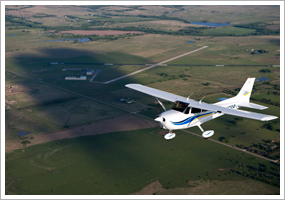| The following stories from the January 15, 2010, edition of AOPA ePilot were provided to AOPA members who expressed an interest in the particular subject areas. Any AOPA member can receive information tailored to their areas of interest by updating their preferences online. - My ePilot -- Helicopter Interest -ADS-B to assist helicopter operationsBy increasing the number of aircraft Houston Center can safely control at one time, the implementation of automatic dependent surveillance-broadcast (ADS-B) in the Gulf of Mexico will improve the safety and operational efficiency of helicopter operators that fly offshore for the oil and gas industry. Helicopter Association International President Matt Zuccaro said, “This is only the beginning phase for the helicopter industry as it moves forward to expand services such as ADS-B and other NextGen technologies to other segments of the industry, including helicopter medical transport, air tours, and high density/complex airspace such as in New York City.” This development supports the industry’s vision of an operating environment for helicopters that would facilitate a seamless transition between visual flight and instrument flight conducted with dedicated, low-level IFR helicopter route structures and point in space instrument approaches. Helicopter flight school first to use FITSMassachusetts-based North Andover Flight Academy appears to be the first helicopter flight school in the world to successfully develop a FITS (FAA and Industry Training Standards) syllabus for its students. Currently in its fourth year, the program was developed by the FAA to design training focused on developing pilot judgment and decision-making skills in technically advanced aircraft. Read more >>
TRAINING TIPsAlternate destinations Your CFI affirms your “go” decision. But surprises are still possible. Don’t let the upbeat moment keep you from pondering the vital question: “What will I do if I cannot reach the planned destination?” If you are heading toward the departing bad weather, destinations in that direction may still be digging out from the storm. When aloft, keep monitoring surface conditions up ahead, and watch for obstacles on the ground after landing. “Check notams and monitor ATIS (automatic terminal information service) broadcasts for closures and delays coded PPR: prior permission required. Snowdrifts created by plowing may be waiting to snag a wing tip; use care especially when maneuvering in confined areas such as on the ramp or while turning at intersections of runways and taxiways. Residual surface ice and refrozen melted snow is a concern even during stretches of good weather,” explained the December 29, 2006, “ Training Tip: Snow, ice, and airports.” If it’s windy with blowing snow, removal operations might have to resume. A trip flown by pilotage could prove challenging. You’d be surprised at the visual transformation a blanket of snow can impose on the landscape. Throw in some lower-than-expected cloud layers and you might face some quick decisions. “Flight planning, in theory, handles the foreseen challenges but diverting from the plan should become a reality when circumstances change. Descending to remain VFR as the ceiling lowers, or proceeding on a heading when you are uncertain of location, could result in the need for a flight assist from ATC,” said the AOPA Air Safety Foundation’s Safety Advisor, Say Intentions… When You Need ATC’s Help . That scenario will be easier to manage if you note the airports you will pass, and know their approximate distance and bearing as you proceed along your route. Doing that also satisfies key elements of the diversion task on your practical test. Often the best alternate airport is the one from which you departed. If it’s time to make that prudent 180-degree turn, doing so without hesitation is the responsible choice. TRAINING PRODUCTSScheyden offers free lenses with frames purchaseNow through Jan. 31, buyers of any of Scheyden’s Dual Rx frames will receive free prescription lenses. The deal is good for bifocal, progressive, single vision, and trifocal prescriptions. Scheyden glasses are unique in the aviation marketplace because of their quick flip-up lenses. Visit the company’s Web site for more information. Note: Products listed have not been evaluated by ePilot editors unless otherwise noted. AOPA assumes no responsibility for products or services listed or for claims or actions by manufacturers or vendors. FINAL EXAMQuestion: I will soon be moving to a different state and need to find a new flight school to finish my private pilot training. Does AOPA have any resources that can assist me in choosing a new flight school? Answer: AOPA can help you in your search for a new flight school. You can search for a school on AOPA Online, and here is a helpful article to help you evaluate different schools to determine which one is the best fit for you. Got a question for our technical services staff? E-mail [email protected] or call the Pilot Information Center, 800/872-2672. Don’t forget the online archive of “Final Exam” questions and answers, searchable by keyword or topic. |
 The latest January storm has exited the area. Now there’s sunshine, blue skies, and bare runways. You’ve been watching the weather improve, keeping tabs on the latest airport conditions, notices to airmen (notams), and pilot reports (pireps). It all adds up to an opportunity to take on that next cross-country.
The latest January storm has exited the area. Now there’s sunshine, blue skies, and bare runways. You’ve been watching the weather improve, keeping tabs on the latest airport conditions, notices to airmen (notams), and pilot reports (pireps). It all adds up to an opportunity to take on that next cross-country.

